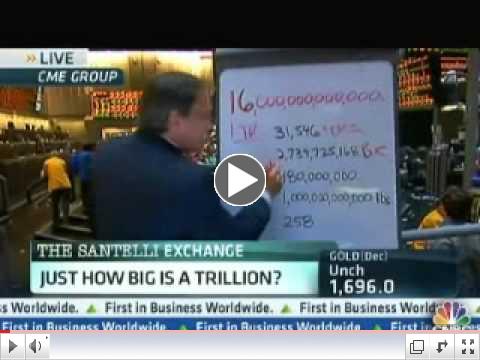 |
| Austin Powers - 100 billion dollars |
Dr. Evil is not alone when it comes to getting his head around large numbers, we all struggle to some extent. Million, billion, trillion, they just seem to roll off our tongues with very little effort, and unfortunately for some, very little thought.
On Tuesday, September 4th our national debt went over $16 trillion, that's $16,000,000,000,000.

It took the United States government over 200 years to accumulate its first trillion dollars of debt. It took only 286 days to accumulate the most recent trillion dollars of debt. 200 years vs. 286 days!
We've become desensitized when it comes to talking about our national debt. Its similar to the threat of a nuclear winter throughout the Cold War. We stopped putting our heads under our desks many years before the Cold War actually ended. It didn't mean that the threat dissipated, we'd just grown tired of it. We've spent so many years hearing about debt that even $16 trillion is a desensitizing stat. It's now not so much, "$16 TRILLION?! HOLY S*^#" as much as, "$16 trillion. Oh...that sucks."
This is the scariest part of this story, we've become so accustomed to throwing around large numbers without really understanding their scale. It's a testimony to our cynically apathetic times, but also, a reminder of how unbelievably fragile this economy is.
In order to help Dr. Evil get his head around the difference between a million, a billion, and a trillion I offer the following visuals:

A million dollars worth of $100 bills fits comfortably in a briefcase. A billion worth of $100 bills would fit in a semi-truck. A trillion worth of $100 bills would fill a skyscraper.
The US Bureau of Engraving and Printing produces 38 million notes a day, so printing one trillion new notes from scratch and working seven days a week, would take just over 72 years.
Stacked in one pile, one trillion one dollar notes, each 0.0043 inches thick, would be 67,866 miles high...the same as 12,344 Mount Everest's (29,029ft). And this is only 1 trillion not 16 trillion!
Rick Santelli of CNBC went on air last Wednesday to try and bring some enlightenment to this weighty issue. One fun stat was that if you were to put every human being on a scale and weigh them you'd get about a trillion pounds. He also went on to comment on the first lady's speech, while not dissing her he notes that unlike her "money's not important to Barack" comment, "when the number gets this big, it better matter to someone."
Watch his excellent rant here:
 |
| Rick Santelli Quantifies One Trillion |
OK, you get the picture, a trillion of anything is a lot. Why this matters is simple. Eventually those who have loaned us this money might actually expect to get it back, and not in newly devalued dollars, but in something more tangible. Even at these extremely low interest rates Uncle Sam is paying out $340 billion in interest payments on our $16 trillion. The interest income that China receives on its US Treasury debt is enough to fund its entire military budget. I always thought it was funny how our Government says we'd defend Taiwan from a Chinese invasion. Funny because we'd first have to borrow the money from China!
Last year the US Treasury brought in $2.57 trillion in tax revenue, and they spent $3.83 trillion, for a one year deficit of $1.27 trillion. Of that $2.9 trillion was spent JUST on mandatory programs like Social Security, Medicare and the Defense budget. In other words we're $330 billion in debt before we even pay a dime in interest.
Fortunately, the world is still willing to fund our deficit spending and fund it at very low interest rates. That doesn't always have to be the case. Someday they may require higher rates of return to fund our profligate ways. Heck, they may not want to fund us at all. In the 19th century, the Ottoman Empire was facing a similar debt crisis. In just 11 years the Ottoman Empire went from spending 17% of its tax revenue on interest to spending 52% of its revenue on interest. Then came default, devaluation, and the end of the Ottoman Empire. Today the US is spending in excess of 10% of its revenues on interest payments. Things happen much quicker today then they did in the 19th century...how much time does the US have?
Sovereign debt is a giant confidence game. Investors buy bonds on the belief that the governments will pay. When that confidence is chipped away (i.e. Greece, Spain, Italy), the cost of capital becomes debilitating.
$16 trillion is a number that will make a few lenders take notice.




No comments:
Post a Comment